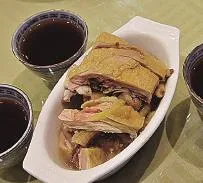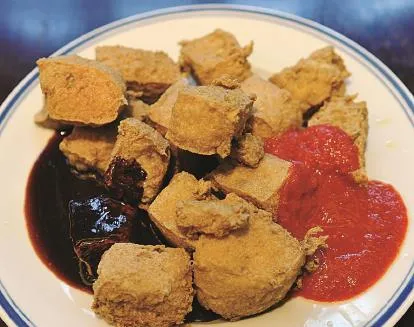The Old and Plain Friends of Yellow Rice Wine
The Old and Plain Friends of Yellow Rice Wine
Even when there are no fancy delicacies, the people of Shaoxing are capable of cooking a tableful of side-dishes to go with drinking using the most basic of ingredients.
Text by Wang Yuanchang Photos by Wang Yuanchang & Chen Yanfei Translation by Sonia
黄酒素友
就算没有山珍海味,绍兴人也能用最普通的食材张罗一桌绝妙的下酒菜。
Aniseed-flavored Beans
Broad beans are the most commonly seen among Shaoxing drinking side-dishes. Among the many different recipes, aniseed-flavored beans are a favourite of the locals. Lu Xun, writer and philosopher, described in the tale Kong Yi Ji that Kong ate aniseed-flavored beans when drinking because it was the only thing he could afford. At that time aniseed-flavored beans were very cheap– two cents for a plateful... So cheap that Kong Yi Ji was able to spare some of his beans for the on looking children. Making aniseed-flavored beans is not hard to do. First you must soak the beans in salt water and then drain them. After repeating the process a few times, cook the beans in a pot. The sophisticated version involves adding cinnamon, aniseed, Shaoxing rice wine, minced ham, sugar, and Shaoxing specialty soy sauce to the pot and cooking on a slow flre for a long time. The simple version only takes some seasoning with aniseed, soy sauce, and salt.
It will take you some time to chew a broad bean, and the longer you chew the more flavors you taste. One thing about drinking old Shaoxing rice wine is taking it slowly by sipping. Broad beans work perfectly with Shaoxing rice wine and is the most economic drinking side-dish.
Drunk Vinasse Chicken
Vinasse dishes all use Shaoxing rice wine as their base ingredient. In the old days, Shaoxing people mostly made their own wine. Vinasse of yellow rice wine is different from that of standard liquor because it has a higher alcohol percentage. Shaoxing people put salt in the yellow rice wine vinasse and leave it in a jar for a year before making vinasse flsh, chicken, and goose with it. Shaoxing people's favorite remains “drunk vinasse chicken”.
The moment drunk vinasse chicken is placed on a banquet table, the appetizing aroma of vinasse fllls the room. The flavor is taken to another level when some pan-fried peppercorn or red hot pepper is added in the vinasse cuision. One thing worth mentioning: the fatter the chicken is, the better the vinasse chicken will taste. Chicken processed with vinasse does not taste greasy at all – with adequate oiliness, it is refreshing, chewy and tasty.
茴香豆
绍兴人最常用的下酒菜就是罗汉豆,即人们所说的蚕豆。在众多不同的制作方法中,茴香豆最受当地人欢迎。鲁迅在《孔乙己》中提到,孔乙己因为没钱,用茴香豆下酒。当时茴香豆很便宜,一二文钱可以买一碟,孔乙己还可分一些给围观的小孩吃。茴香豆的制作并不难,先将豆用盐水浸泡再阴干,这样反复几次,再放入锅里煮。制作讲究的,加些桂皮、茴香、绍兴酒、火腿肉末、糖、母子酱油等,长时间文火煮。随便点的,加点茴香和酱油、盐之类的佐料即可。
放一颗罗汉豆在口里,可以嚼上好一会儿,而且越嚼越香,越嚼越有滋味。吃绍兴老酒的一个特点就是慢,要“咪”酒,罗汉豆正可以配合这种特点,也是最节省的下酒菜。
醉糟鸡
糟菜其实是借绍兴酒而得名的。以前,绍兴乡人多自己酿酒。制过黄酒的酒糟与烧制白酒的酒糟不同,里面还有许多酒的成分。绍兴人便将黄酒糟加上盐,放在酒罐或坛里闷上一年,用来制作糟鱼、糟鸡、糟鹅等。绍兴人最喜欢的还是醉糟鸡。
醉糟鸡一放上餐桌酒席,就糟香四溢,令人垂涎。假若在酒糟上再加入一些经过炒制的花椒或小红辣椒等佐料,则风味更佳了。值得一提的是,凡用于糟制的鸡,肥者为佳。因为经过糟制的肉类食品肥而不腻、油润有度、入口爽滑、嚼之有味。

Stinky Tofu
Shaoxing stinky tofu is one of the four famous stinky tofus in China. It is old and traditional – “stinky by smell, delicious by taste” as the saying goes. Once you take a bite, you will flnd yourself going back for more.
Here is a daily routine at the food stalls of Shaoxing. Imagine the set up: deep-fry wok on a stove on one side, wood plate on the other; seasoning jars and bamboo sticks placed on the wooded plate. The stinky tofu is turning gold and brown with sizzling sound. A combination of stinky-delicious smell fllls the air. Watching the fried stinky tofu dripping oil one-by-one on the iron sieve, the customers all buy with happy faces.
Savory Preserved Food
The preserved food in Shaoxing is considered the best in China because of its thousand-year history, unique spices, and the seasoning and coloring from the yellow rice wine. Among the diverse preserved food from all over the country, such as sausages, pork, flsh, chicken, ducks, and ham, one can easily distinguish Shaoxing from the others at flrst bite.
Many villages make preserved food in the Shaoxing region. Anchang village is the most authentic and ancient. In the twelfth month of a lunar year, every family in Anchang hangs up their preserved food everywhere in the house and the whole neighborhood is fllled with the delicious smell. The sausage looks reddish brown under the sun, beaming as if it is oiled; it looks blackish brown in dim light and appears solid – it is actually soft by touch and the meat looks as if it is bursting the casing. Chew slowly and you will taste through the texture of meat the unique aroma of yellow rice wine, lingering in the mouth for quite a while

臭豆腐
绍兴臭豆腐,是中国四大臭豆腐之一。它古老而传统,“闻着臭,吃着香”,一经品味,常令人欲罢不能。
在绍兴的小吃摊,每天都在上演着这样的场景,一旁小灶油锅,另一旁是木格案板,油锅小沸,案板上调料瓶、竹签。随着 “吱、吱”声响,臭豆腐渐渐被炸成金黄色,亦臭亦香的气息弥漫开来。看着炸好的臭豆腐一块块放在铁丝篦上滴着油,食客们脸上堆满了幸福。
醇香腊味
因经千年工艺锤炼、配料独特,又因都由黄酒调味上色,绍兴腊制品形成了独有的风味,堪称中国“腊中一绝”。在各地花样众多的腊制品中,如腊肠、腊肉、腊鱼、腊鸡、腊鸭、腊火腿等,唯独绍兴的,第一口就能吃出专属的味道来。
绍兴很多乡村做腊制品,其中以安昌古镇最地道、历史最久。腊月里的安昌,家家户户台门前、台门里都挂满了腊制品,满街飘香。强光下的腊肠呈红褐色,晶亮似涂抹了油脂,暗光下呈黑褐色,看似坚硬如石,像要撑爆了皮,摸上去还蛮有弹性。慢慢咀嚼,柔软的肉质中透出黄酒独特的香气,久久存留在唇齿之间。

